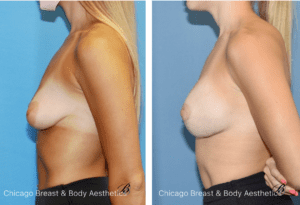BEST BREAST LIFT SURGEON Near Me | CHICAGO, IL
Restore and Lift your
Breasts with a Breast Lift (Mastopexy)

what is a breast lift
A mastopexy breast lift is a cosmetic breast procedure designed to lift a “droopy” or ptotic breast. The procedure is different from a breast augmentation in which the breasts are simply enlarged with an implant.
A mastopexy can be done in conjunction with a breast augmentation in which case the procedure is known as an augmentation-mastopexy.


Who is a Good Candidate For A Breast Lift?
You may benefit from a breast lift if you have significant ptosis, or drooping of the breast, where the nipple is at the bottom of the breast or below the infra-mammary crease, you will likely be a candidate for a breast lift.
The purpose of the lift is to restore the nipple-areolar-complex and inferior pole of the breast back up above the infra-mammary crease. During your evaluation, your surgeon can evaluate the degree of ptosis (I-IV) and tell you if a lift is also recommended.

What is breast ptosis?

Drooping or sagging of the breast, or ptosis, is defined as having the nipple and areola as well as breast parenchyma (breast tissue) falling below the infra-mammary fold.
Ptosis typically occurs following pregnancy and breast feeding, but can also occur after weight loss, or with aging. Sometimes breasts can develop with congenital ptosis, such as in cases of tubular breast deformity or breast constriction. There are varying degrees of ptosis and it is generally graded from I to IV.
A Non-ptotic breast with zero ptosis, has the nipple, areola and parenchyma (glandular and fatty tissue which make up the breast) sitting ABOVE the the infra-mammary fold (The crease below the breast). Patients with non-ptotic breasts do not need breast lift. An augmentation with implants will give a great aesthetic result.
Grade I ptosis is considered mild drooping where the nipple-areola lies AT THE SAME LEVEL of the infra-mammary fold and the parenchyma below it. Patients with Grade I ptosis usually do not need a breast lift. An augmentation with careful sizing and profile choice as well as well-thought-out placement will usually give a great aesthetic result.
Grade II ptosis is considered moderate drooping in which the nipple-areola lies BELOW the level of the infra-mammary fold but remains above the lowest hanging (or most dependent) part of the parenchyma. Patients with Grade II ptosis will usually require a breast lift.
Grade III ptosis is severe sagging in which the nipple lies well below the infra-mammary fold and lies at the bottom of the breast, at the lowest hanging part of the parenchyma along the inferior contour of the breast.
Grade IV or Pseudo-ptosis is not true ptosis. The nipple-areola lies above the level of the infra-mammary fold. However, the majority of the breast tissue has fallen below the level of the infra-mammary fold.
Parenchymal maldistribution occurs when the breasts develop in such a way that there is very little breast tissue in the lower pole, and the nipple-areola are sitting at the bottom of the breast mound. the distance between the nipple to the infra-mammary crease is shortened and the areola may be unusually wide. This anatomy is seen in cases of constricted breast or tubular breast development.
How is a breast lift surgery performed?

A mastopexy is surgical procedure in which the nipple-areola are moved back to their position above the infra-mamammary fold. The excess droopy breast tissue in the lower pole is partially removed and the lower part of the breast is reconstructed. There are several different types of mastopexies depending on the degree of ptosis and anatomy. Your surgeon will discuss the type of incision recommended during your evaluation.
Will I have scars from a breast lift Surgery?
Yes, a breast lift surgery cannot be done without leaving scars. Mastopexies do leave scars on the breast depending on which incision your surgeon chooses. However, the breast is an amazing structure in that it is very forgiving of scars if the incisions are done correctly without undue tension and no infection or inflammation occurs. In some cases, the scars may be hidden in the natural creases of the breast. The scars will fade over time and eventually may become almost invisible, but there will always be at least some faint scars.

How long does a breast lift procedure take?
The length of the procedure will depend on the amount of tissue being removed as well as whether or not an implant is being placed at the same time, such as in augmentation-mastopexy. Typically, a mastopexy will take between 2 to 4 hours depending on your individual case.

Does a breast lift require anesthesia?
A breast lift is considered a reconstructive surgery and general anesthesia is recommended. Your procedure will be performed at our surgery center. It is done as an outpatient procedure typically where you should be able to go home the same day, often an hour or two, after your procedure.

What is the recovery process for a breast lift?
After a breast lift you should expect to be able to walk the same day or next day. Most patients are back to work within a week.
- Week 1: Get plenty of rest. You will be asked to schedule your first post-operative visit within the first week of surgery.
- 4-6 weeks: You will not be allowed to submerge in water or swim for 4-6 weeks.
- 8-12 weeks: You should be back to your usual workout routines by 8-12 weeks.
- 6 months: Your final result with settling of the breast and softening of the skin may not be fully evident until 6 months or more.

Is a breast lift painful?
With any surgery, you have to expect some discomfort. Typically a breast lift does not involve excruciating pain and most patients are relatively comfortable without pain medication within a few days.
Our practice use a long-acting, extended-release bupivicaine to anesthetize the area for 48-72 hours to help with any patient discomfort.
Will I lose nipple sensation after a breast lift?
Some numbness of the nipples can occur immediately following a breast lift, but this almost always temporary. Some women report increased nipple sensitivity. It is a risk to lose nipple-sensation, but the risk is low.
Can I still breast feed after a breast lift?
There is a risk that you may lose the ability after a Breast Lift, since the nipple-areola are re-positioned. However this may depend on the technique and pedicle used, and the amount of dissection around the important ducts. In most but not all cases, patients are still able to produce milk and breast feed even after a breast lift.

How much does breast lift surgery cost in Chicago?
The cost of a breast lift depends on many factors, including the skill and experience of the surgeon, the geographic region, the type of breast lift, or whether implants are used.
At Chicago Breast & Body Aesthetics, we offer competitive all-inclusive pricing including monthly specials and discounts. We also offer multiple options for financing to accommodate almost any situation or budget.
Breast Lift Before & After Gallery
Top Rated Cosmetic & Plastic Surgeons In Chicago, Illinois
Dr. Anh-Tuan Truong
Dr. Truong holds three board certifications, including the American Board of Surgery, the American Board of Cosmetic Surgery, and the American Board of Facial Cosmetic Surgery. Dr. Truong was voted one of America's Top Cosmetic Surgeons.
Dr. Kevin Lin
Dr. Pey-Yi Kevin Lin is a board-certified plastic surgeon in Chicago who emphasizes tailored care and treatment to each patient. Dr. Lin is skilled in plastic and Reconstructive surgery and completed his fellowship at the University of Texas.
Dr. Francine Vagotis
Dr. Vagotis is a board-certified plastic surgeon specializing facial surgery. She’s one of the few surgical professionals to have had the opportunity to learn under famous facelift practitioner, Dr. Bruce Connell, known as “the father of the modern face lift”.
Get A Complimentary Body Analysis & Consultation (Regularly $250)
VERIFIED PATIENT REVIEWS



The Time Is Now, Begin Your Transformative
Journey to a Happier, More Confident You Today!

Get A Complimentary Virtual Consultation (A $250 Value) Today!
REVIEWS
















